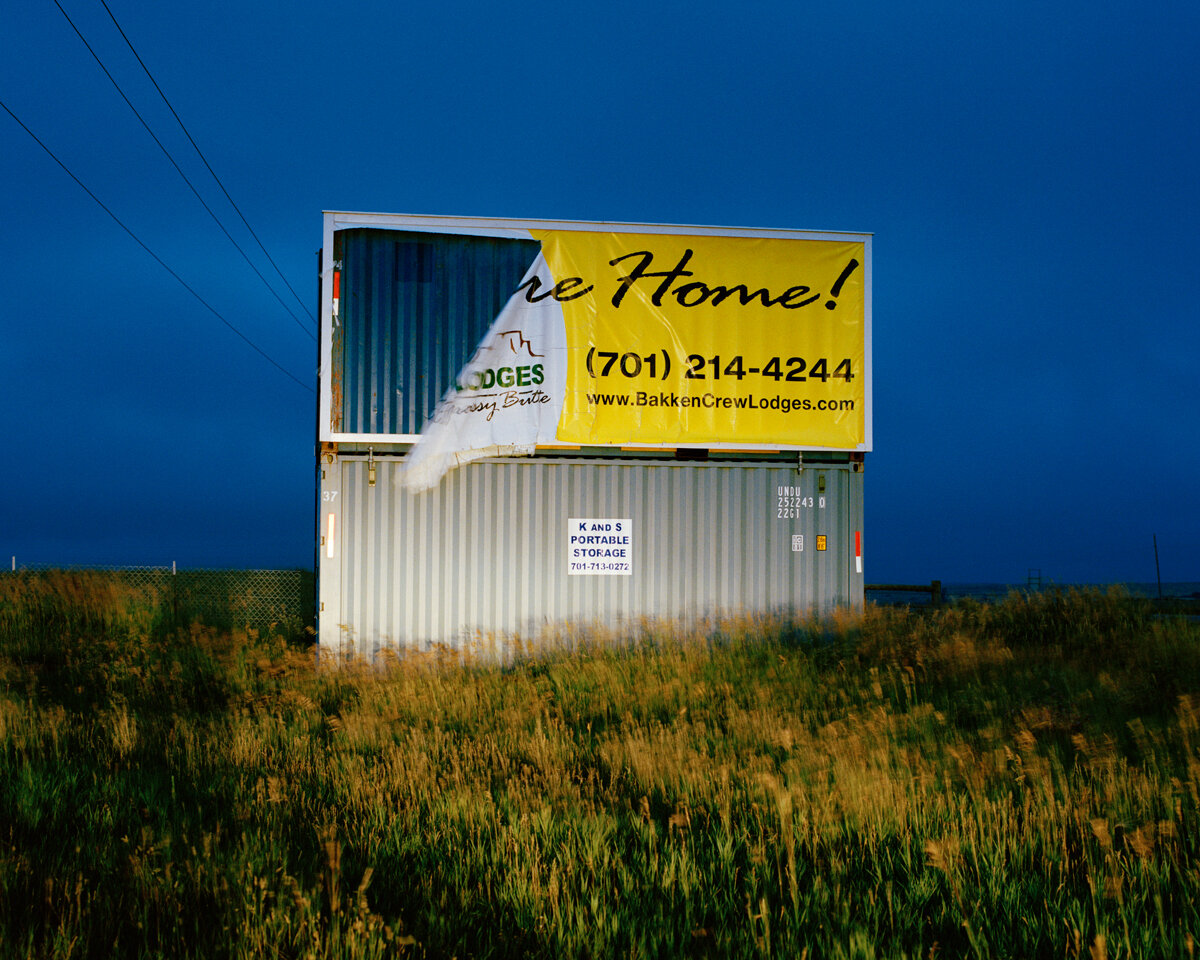When the Landscape is Quiet Again: North Dakota's Oil Boom by Sarah Christianson
Since 2012, I have been documenting the legacy of oil booms and busts in my home state of North Dakota. My photographs bear witness to the transformation of its quiet agrarian landscape into an industrialized zone dotted with well sites, criss-crossed by pipelines, illuminated by natural gas flares, contaminated by oil and saltwater spills, and fracked beyond recognition.
Everyone wants a piece of the action, including my family: since the Bakken Boom began, we have been profiting from oil wells drilled on land my great-grandparents homesteaded in 1912. Although many other families are doing the same, I started this project to reconcile our involvement with the hidden costs of this prosperity.
In 1973, Governor Art Link envisioned: “We do not want to halt progress… We simply want to insure the most efficient and environmentally sound method of utilizing our precious resources for the benefit of the broadest number of people possible. And when we are through with that and the landscape is quiet again…let those who follow and repopulate the land be able to say, our grandparents did their job well. The land is as good and in some cases better than before.”
Unfortunately, his hope for the future remains a fantasy: our grandparents did not do their job well. I examine the scars from prior boom-and-bust cycles and the new wounds being inflicted upon my home because the status quo must change: something needs to be left for the next generation, not the next quarter.
Sarah Christianson lives and works in Oakland, CA.
To view more of Sarah’s work, please visit her website.
Flaring near the Blue Buttes, January 2015
Natural gas is being flared off in North Dakota due to a lack of infrastructure. Before new policies were adopted in 2014, upwards of 30% was being burned and wasted.
The Badlands south of Medora, July 2014
Infrastructure from the state’s two prior boom-and-bust cycles can still be found across the landscape, like this 1970s era flare stack. Aging equipment is one of the leading causes of spills and environmental contamination.
Carole at her parents’ graves, July 2016
Carole is a fourth-generation rancher near Watford City, in the heart of the oil patch. She says, “People don't understand what this costs the landowners. We all wanted this oil development. We just didn’t know what we were in for. Even half of what we got would’ve been too much. Our way of life has changed. It’s never going to be the same… I’m glad that my Mom & Dad didn’t live to see this.”
Flaring seen from Carole’s ranch, May 2019
Bakken Crew Lodges man camp near Grassy Butte, July 2016
Tioga: Oil Capital of North Dakota, September 2017
On April 4, 1951, the Clarence Iverson No. 1 became the first well to strike oil in North Dakota, just south of Tioga. This discovery ushered in the state’s first oil boom.
Corn field, Bottineau County, September 2013
For the first time ever in the state’s history, the oil industry surpassed the agricultural sector as North Dakota’s No. 1 economic force in 2013. Newspaper headlines across the state proclaimed, “King Oil dethrones King Ag.”
Removing 865,200 gallons of oil from the Jensens’ land, July 2014
On September 29, 2013, the largest inland oil spill in the United States was discovered by Steve Jensen as he was harvesting wheat. Enough oil to fill 3 Olympic-sized swimming pools had leaked into his field from a 20-year-old pipeline.
Ongoing oil spill cleanup efforts on the Jensens’ land (year 3), July 2016
In the end, it took five years and $93 million to remediate this spill site. Over 1.2 million tons of soil was excavated and treated from a 48-acre area, and less than a third of the spilled oil was recovered. The Jensens planted their first cash crop on the site in 2019.
Flax from the Petersons’ saltwater-damaged field, September 2013
Saltwater is an industry byproduct that can be 30 times saltier than the ocean. It burns the land, making healthy agricultural production impossible. After their field experienced 7 saltwater spills in two years, the Petersons wondered, “Why should we have to sacrifice our farmland to careless operators?”
Million gallon saltwater spill site near Bear Den Bay, Ft. Berthold Reservation, July 2015
A year after this toxic wastewater flowed downhill through a ravine to Lake Sakakawea, Lisa & Walter DeVille examine the still-contaminated spill area. Although tribal officials believe their water supply was not affected, a study conducted by Duke University researchers proves otherwise.
Mandaree Pow Wow, July 2015
“Buffalo Pad” near Skunk Bay, Ft. Berthold Reservation, July 2014
The oil industry is trying to minimize environmental impacts by building larger well pads with multiple oil wells on them. These “ECO-Pads” reduce the overall amount of land needed per individual well.
Dakota Access pipeyard, Richardton, September 2015
Pipes were stockpiled here in Richardton, as well as two other locations in North Dakota, before regulators even approved the pipeline project.
Dakota Access Pipeline construction near Standing Rock, October 2016
This heavily protested pipeline carries oil from western North Dakota to its terminus in Illinois. It bores underneath the Missouri River, less than a mile from the Standing Rock Sioux Reservation.
Pipeline near Lake Sakakawea, July 2016
Thunderstorm near Alexander, July 2015
Thousand Dollar Way, February 2016
TJ’s Salvage Yard, February 2016
After the Bakken Boom experienced its first bust in 2014, many oilfield workers simply walked away and abandoned their makeshift housing. Scores of RVs and trailers were towed from the region’s man camps to this salvage yard on Highway 85, just south of Williston.
Oil tanker north of Williston, February 2016




















